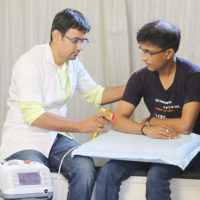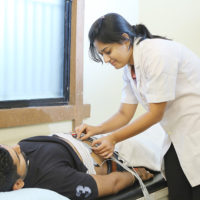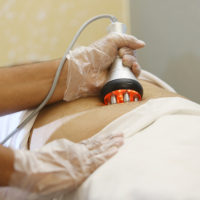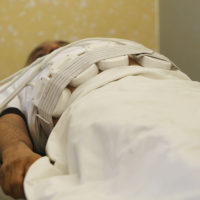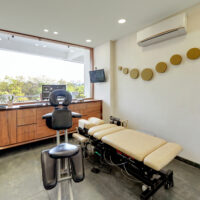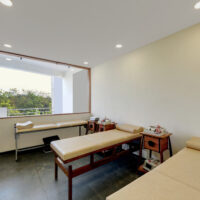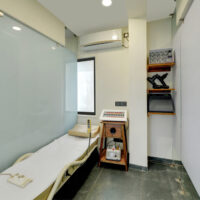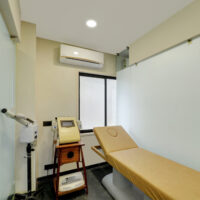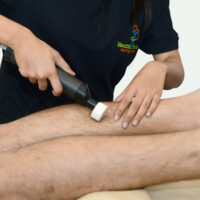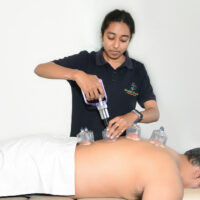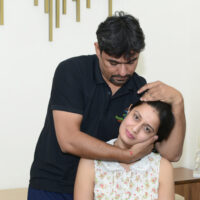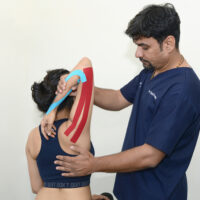Foot pain can have causes that aren’t due to underlying disease. Examples include poorly fitting shoes, prolonged period on feet, overuse such as long walks or running a marathon, sprains, strains or trauma.
Foot Pain
Plantar fasciitis is a condition in which the plantar fascia, a band of tissue that runs along the bottom of the foot from the heel to the toes, becomes inflamed and painful. This can cause a stabbing pain in the heel or arch of the foot, especially when taking the first steps after a period of rest, such as in the morning.
Plantar fasciitis is often caused by overuse, improper footwear, or underlying medical conditions such as flat feet or high arches. It is more common in runners, people who are overweight, and those who spend long periods of time standing or walking on hard surfaces.
Symptoms of plantar fasciitis may include:
- Pain in the heel or arch of the foot, which may be sharp or dull
- Stiffness and limited range of motion in the foot
- Aching or burning sensation in the affected area
- Pain that is worse after periods of rest or prolonged standing
- Practice proper footwear selection Avoid high heels and shoes with inadequate arch support.
- Consider using orthotic inserts like heel pads or custom orthotics to provide additional support if needed.
- Engage in regular stretching exercises to maintain flexibility in the ankles and surrounding muscles to prevent stiffness around the ankle
- Gradually increase the intensity and duration of your exercises or sports to allow your body to adapt and avoid overuse injuries.
- Incorporate cross-training and alternate between different activities to avoid overuse of the area around the heel
- Maintain a healthy weight of the body
- Prior to engaging in physical activity or exercise, warm up your muscles and tendons with light aerobic exercises and dynamic stretches.
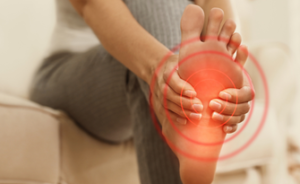
Calcaneal Spur
Calcaneal spur, also known as heel spur, is a bony growth that develops on the bottom of the heel bone. It is typically associated with plantar fasciitis, a common condition that causes pain and inflammation in the thick band of tissue that runs from the heel to the toes.
The exact cause of calcaneal spur is unknown, but it is believed to be related to repetitive stress and strain on the heel bone and surrounding tissues. Risk factors for developing calcaneal spur include obesity, overuse of the feet, and wearing shoes with poor arch support or shock absorption.
Symptoms of calcaneal spur may include:
- Pain or tenderness in the bottom of the heel, particularly with weight-bearing activities such as walking or running
- A visible bony growth on the bottom of the heel
- Swelling or redness around the affected area
- Difficulty with standing or walking for prolonged periods
- Practice proper footwear selection Avoid high heels and shoes with inadequate arch support.
- Consider using orthotic inserts like heel pads or custom orthotics to provide additional support if needed.
- Engage in regular stretching exercises to maintain flexibility in the ankles and surrounding muscles to prevent stiffness around the ankle
- Gradually increase the intensity and duration of your exercises or sports to allow your body to adapt and avoid overuse injuries.
- Incorporate cross-training and alternate between different activities to avoid overuse of the area around the heel
- Maintain a healthy weight of the body
- Prior to engaging in physical activity or exercise, warm up your muscles and tendons with light aerobic exercises and dynamic stretches.
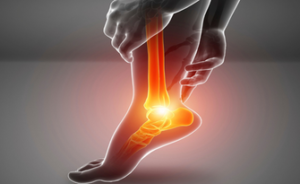
Achilles Tendinitis
Achilles tendinitis is a condition in which the Achilles tendon, the large tendon that connects the calf muscles to the heel bone, becomes inflamed and painful. This can cause pain and stiffness in the back of the ankle, especially during activity.
Achilles tendinitis is often caused by overuse or repetitive stress on the tendon, as well as improper footwear or a sudden increase in physical activity. It is more common in runners and other athletes, but can also occur in non-athletes.
Symptoms of Achilles tendinitis may include:
- Pain and stiffness in the back of the ankle, especially during activity
- Swelling and tenderness in the affected area
- A crunchy or creaking sensation when moving the ankle
- Thickening of the tendon
- Gradually increase the intensity and duration of your exercises or sports to allow your body to adapt and avoid overuse injuries.
- Practice proper footwear selection Avoid high heels and shoes with inadequate arch support.
- Engage in regular stretching exercises to maintain flexibility in the ankles and surrounding muscles to prevent stiffness around the ankle
- Strengthening the muscles around the ankle joint can provide better support and stability
- Pay attention to any signs of pain, discomfort, or stiffness in your Achilles tendon, ignoring early warning signs can lead to worsening of the condition.
- Maintain a healthy weight of the body
- Proper Warm-up and cool-down before workout
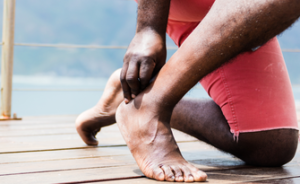
Tarsal Tunnel Syndrome
Tarsal tunnel syndrome is a condition in which the tibial nerve, which runs down the back of the leg and into the foot, is compressed as it passes through a narrow tunnel called the tarsal tunnel. This can cause pain, numbness, and tingling in the foot and ankle.
Tarsal tunnel syndrome is often caused by overuse, injury, or underlying medical conditions such as flat feet or arthritis. It is more common in athletes, people who stand for long periods of time, and those who wear tight or poorly fitting shoes.
Symptoms of tarsal tunnel syndrome may include:
- Pain, numbness, or tingling in the foot or ankle, which may be worse at night
- A burning or electric shock sensation in the affected area
- Weakness or loss of sensation in the foot or toes
- Swelling in the ankle or foot
- Wear shoes that provide adequate support, cushioning, and room for your feet. Avoid tight-fitting shoes or those with narrow toe boxes that can compress the nerves in the tarsal tunnel.
- Use orthotic inserts can help improve foot alignment, reduce excessive pronation or supination, and alleviate pressure on the tibial nerve.
- Regularly perform stretching exercises to improve flexibility and reduce tension in the muscles and ligaments surrounding the ankle
- Avoid repetitive activities that involve repetitive motions or prolonged periods of standing or walking
- Try to avoid prolonged periods of standing or activities that put excessive pressure on the feet and ankles
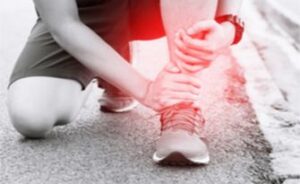
Flat Feet or Fallen Arch or Pes Planus
Flat feet, also known as fallen arches or pes planus, is a condition in which the arches of the feet are flattened, causing the entire sole of the foot to make contact with the ground. This can cause pain and discomfort, particularly during prolonged standing, walking, or running.
Flat feet can be caused by a variety of factors, including genetics, injury, or certain medical conditions such as arthritis or diabetes. It can also be a normal variant in some people and may not cause any symptoms.
Symptoms of flat feet may include:
- Pain or discomfort in the feet, particularly the arches or heels
- Fatigue or cramping in the feet or legs, particularly during physical activity
- Difficulty standing or walking for prolonged periods
- Uneven wear on the soles of shoes
- Wear supportive footwear with built-in arch support or consider using custom orthotic inserts or arch supports to help support the arches and distribute pressure more evenly.
- Avoid high heels and unsupportive footwear can exacerbate the problems associated with flat feet
- Use proper footwear for specific activities like running, jumping, or high impact activities
- Regularly perform stretching exercises to improve flexibility and reduce tension in the muscles and ligaments of the feet and calves
- Avoid prolonged standing or walking
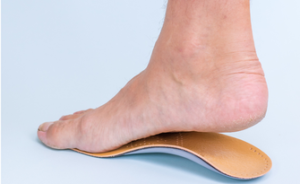
Morton’s Neuroma
Morton’s neuroma is a condition that affects the nerves in the ball of the foot, causing pain, numbness, and tingling in the affected area. It occurs when the tissue around one of the nerves leading to the toes becomes thickened, causing compression and irritation of the nerve.
Morton’s neuroma is often caused by wearing tight or ill-fitting shoes, particularly those with high heels or narrow toe boxes. It is also more common in women and those who participate in high-impact activities such as running or jumping.
Symptoms of Morton’s neuroma may include:
- Pain or discomfort in the ball of the foot, particularly between the third and fourth toes
- Numbness or tingling in the affected area
- A sensation of a lump or thickening under the ball of the foot
- Burning or shooting pain in the affected area
- Wear supportive footwear with built-in arch support or consider using custom orthotic inserts or arch supports to help support the arches and distribute pressure more evenly.
- Avoid high heels and unsupportive footwear can exacerbate the problems associated with flat feet
- Use proper footwear for specific activities like running, jumping, or high impact activities
- Regularly perform stretching exercises to improve flexibility and reduce tension in the muscles and ligaments of the feet and calves
- Avoid prolonged standing or walking

Hallux Valgus
Hallux valgus, also known as a bunion, is a common condition in which the big toe deviates outward toward the other toes, causing a bump to form on the inside of the foot. This can cause pain, swelling, and difficulty with wearing shoes.
The exact cause of hallux valgus is unknown, but it is believed to be related to a combination of genetic and environmental factors. Wearing tight, narrow, or high-heeled shoes can also exacerbate the condition.
Symptoms of hallux valgus may include:
- A bump on the inside of the foot, near the big toe joint
- Pain or discomfort in the affected area
- Swelling or redness around the affected area
- Difficulty with wearing shoes or finding shoes that fit comfortably
- Wear proper footwear that provide adequate room for your toes and have a wide toe box. Avoid narrow or tight-fitting shoes that compress the toes and increase pressure on the big toe joint.
- Avoid high heels and pointy-toed shoes as high heels and shoes with narrow toe boxes can exacerbate the problems associated with hallux valgus
- Use proper footwear for specific activities like running, jumping, or high impact activities
- Regularly perform stretching exercises to improve flexibility and reduce tension in the muscles and ligaments of the big toe
- Avoid activities that worsen symptoms or cause pain in big toe
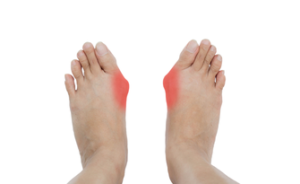
YOUR NEXT STEPS!
-
Request An Appointment
-
Find the Root Cause and Receive A Custom Treatment Plan
-
Monitor Progress
-
Recover & Get Back to Life!
